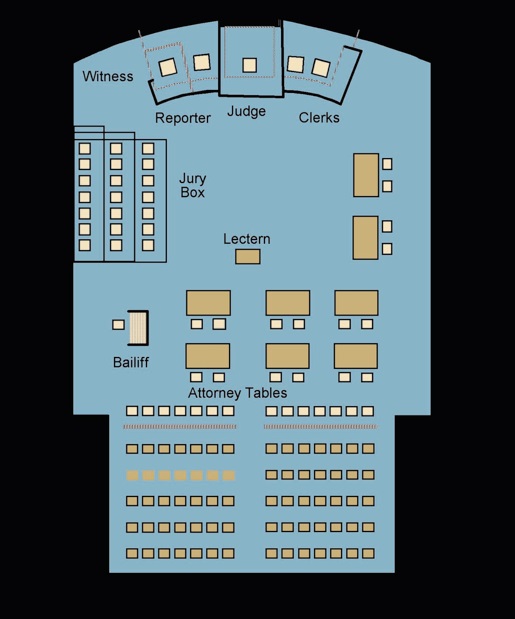Multi-Defendant Mega Courtroom
Some areas of the Country have seen the development of lengthy, multi-party trials. The accommodation of as many as 100 attorneys with many different defendants or plaintiffs, the possibility of multiple juries, and the need to process, store, and retrieve huge volumes of testimony, exhibits, and evidence all present very special design problems.
Because of the large number of people, the litigation space must be considerably larger than in a regular trial courtroom. Large courtrooms require advanced sound systems, video cameras, video display monitors, and computers for keeping track of thousands of pleadings and exhibits.
Caution, however, should be exercised in the consideration of a multi-defendant courtroom, because most communities do not need such a facility. This may be a once in a lifetime event. An alternative approach is to construct a temporary “mega-courtroom” for such special trials, financed by court fees in civil cases. Where this has been done, the courtroom has been located outside the courthouse in auditoriums or hotel ballrooms, and expenses were borne by the litigants. Even where it may be justified, designing a suite of several courtrooms that could be converted into one large mega-courtroom is another option. The disadvantage, however, is that if the mega-courtroom configuration is needed, the court must give up several courtrooms for the length of the trial.
 |
Because the courtroom floor plan needs to be flexible, movable and modular furniture settings are recommended, but it is important to maintain a dignified judicial atmosphere. The courtroom floor may need to be raised to permit the running of phone, computer, audiovisual, and security alarm cables.
Multi-defendant courtrooms require much larger litigation areas, as they may need to accommodate multiple attorneys. Space needs to be made for multiple counsel tables. Multiple juries and the need for multiple jury boxes will also affect the size of the litigation area. Overall space needs may exceed 3,000 square feet.
Extra large courtrooms require special ventilation systems. The need for meeting spaces, extra large corridors to handle the large number of attorneys, and larger courtrooms may preclude the use of natural lighting.
Space for microphones and video display equipment needs to be provided. Because of the large litigation area, attorneys at the rear of the courtroom may not be able to see what is happening, or even the witnesses. For this reason, court proceedings may need to be viewed by closed-circuit television. Attorneys should have a buzzer connected to the judge's bench to notify the judge of objections. Each attorney station should be equipped with phone jacks, data jacks, security line, and video cabling. The large volume of pleadings and paper exhibits will require document imaging to store images of exhibits and court documents. All workstations and courtroom positions will require video display monitors for the viewing of imaged documents and evidence.